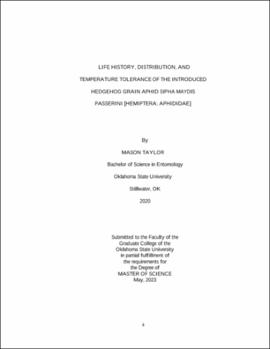| dc.description.abstract | Sipha maydis Passerini (Hemiptera: Aphididae), the hedgehog grain aphid, is a cereal grain pest that is suspected to be a native species from Europe or Northern Africa. These aphids are also found in Asia and both Americas on crops and native grasses. S. maydis started to become and problem and became monitored more strictly after an outbreak on wheat in 2002 in Argentina. In 2007, the first documentation of the species in the U.S. was in California on giant wild rye with sightings spreading to the east quickly. Since this aphid is possibly invasive and in the U.S. we tested three aspects of its biology. 1) The current distribution of this aphid has increased since 2019; 2) S. maydis has an optimal temperature, measured by intrinsic rate of increase between 20 and 30°C; 3) Comparing the life history of S. maydis and Melanaphis sorghi will document existing host-plant cross-resistance. Testing these hypothesis we sampled in the Rocky Mountain Range and Plains states of OK, NM, CO, UT, and WY. These surveys documented that S. maydis has not spread or increased. However, aphids were found on a variety of grass species and a new host was identified. Optimal thermal range was tested by placing 12 aphids on the laboratory rearing host plant, Jagger wheat, in temperatures of 10, 15, 20, 25, 30 and 35°C. Aphids were observed until death and intrinsic rate of increase was calculated for each temperature. Optimal temperatures for S. maydis were between 20 and 25°C. Third, we compared S. maydis to M. sorghi using 5 different cereal grain varieties, TX7000 sorghum, TX2783 sorghum, KS585 sorghum, Custer wheat and Millex32 millet, observing each aphid until death to calculate the intrinsic rate of increase. Both species reproduced on sorghum with M. sorghi performing better on known susceptible TX7000. In contrast, S, maydis reproduced at approximately the same low rate on all tested plants while M. sorghi did not reproduce on wheat or millet. Overall, S. maydis does not appear to pose a threat of becoming an invasive pest, but continued monitoring is warranted. | |
